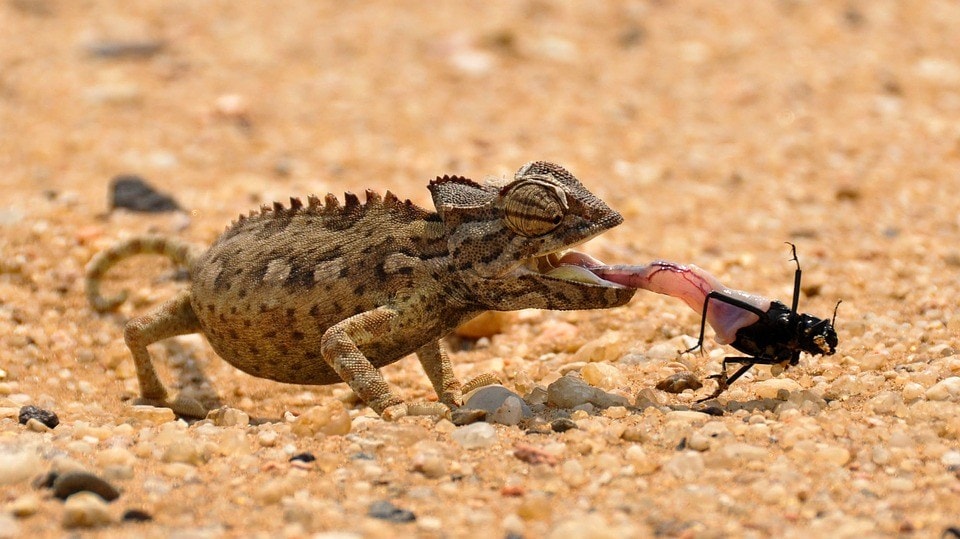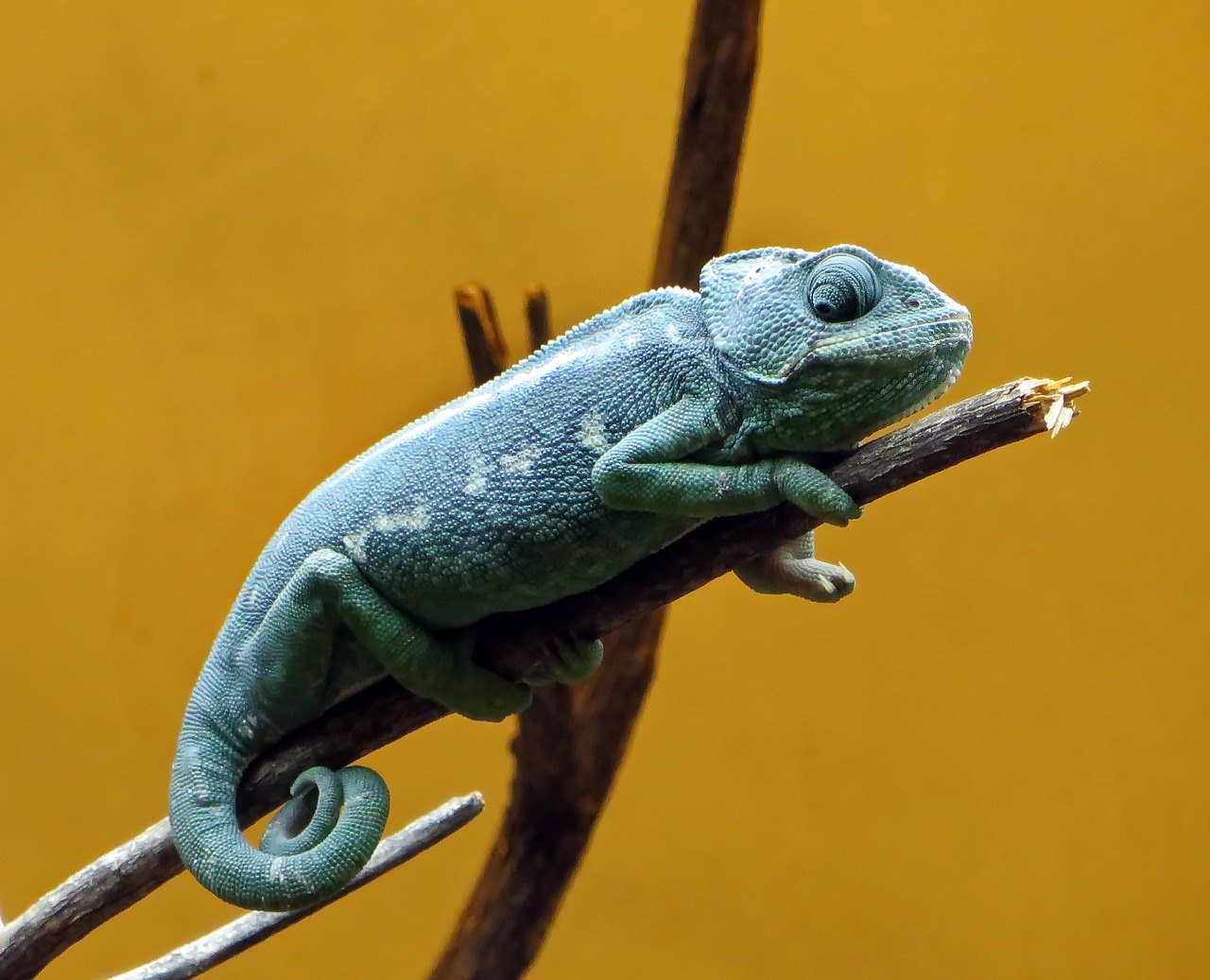
If there’s one animal that most people are mesmerized with, it has to be the color-changing chameleon. These beautiful creatures change color so they blend in with their environment. By camouflaging themselves, chameleons stay safe from predators and use their disguise to capture prey. There are dozens of species of chameleons in the world and some can change colors while others cannot.
If you’re thinking of getting a chameleon and wonder what they eat in the wild and captivity, we’ve got the answers for you! In the wild, chameleons enjoy a diet consisting mostly of insects. Some of the larger species even eat small lizards and birds. Some chameleons eat plant material and even berries to supplement their diet.
 Types of Insects Chameleons Eat in the Wild
Types of Insects Chameleons Eat in the Wild
Because they mostly eat insects, chameleons are classified as insectivores. In their natural habitat, these animals eat a wide variety of insects which often include:
Where Chameleons Live and Their Role in the Ecosystem
Like other lizards, chameleons favor warm weather. This is why chameleons are found in areas of the world that have warm climates including Madagascar, Africa, Southern Europe, Sri Lanka, India, the Middle East, and islands of the Indian Ocean.
Chameleons are a crucial part of the ecosystem. This reptile is both a predator and prey. Chameleons help keep the insect population in check and they are a food source for a variety of animals like snakes and birds.

How Chameleons Capture Insects in the Wild
As you may know, most chameleons are not fast movers. Since these animals cannot move quickly, many people wonder how they’re able to catch fast-moving insects to eat in the wild.
Chameleons have excellent eyesight and can see their prey from about 10 yards away. The eyes of these reptiles move independently of each other giving chameleons a 360-degree view of their environment. A chameleon can keep one eye looking in one direction while the other eye is focused on something else like a flying insect it wants to eat. When it’s time to catch its prey, the chameleon uses its long and sticky tongue to quickly capture the prey.
On top of its amazing eyesight and lightning-quick tongue, a chameleon uses camouflage to catch prey. Chameleons spend most of their time in plants, bushes, and trees where they blend in with their environment. The brown and green colors of chameleons provide them with perfect camouflage as they stay still waiting for prey to appear. When prey is near, a chameleon will quickly strike with its long sticky tongue wherein it’s all over for the unsuspecting insect!
What Pet Chameleons Eat
Like chameleons living in the wild, pet chameleons enjoy eating a variety of insects. However, some of these reptiles like veiled chameleons also eat leafy greens like kale, endive, dandelion greens, collard greens, and mustard greens. If you’re planning on getting a chameleon, you should be 100% sure that you’ll be willing and able to provide your animal with the food it likes including live insects.
Most pet stores sell live insects to feed chameleons like crickets and a variety of worms like wax worms, mealworms, and silkworms. It’s a good idea to increase the nutritional value of the insects you feed a chameleon. You can do this by dusting the insects with a vitamin/mineral powder you can find at local pet stores and online. This powder is easy to use. You simply shake a bit into a small plastic bag, drop in a few live insects like crickets, and give them a gentle shake so they get covered with the dusty powder. Then simply feed the insects to your chameleon.
- Related Read: What do Crickets eat?

Types of Fruits and Veggies Pet Chameleons Like
While insects make up the majority of a chameleon’s diet, like us humans, chameleons like to mix it up now and then. This is especially true once a chameleon has reached maturity. Once your chameleon reaches adulthood, keep feeding it the insects it likes but try some other foods to give your reptile a little variety. Some fruits and vegetables to try include:
It will be a matter of hit or miss when you start expanding your chameleon’s diet as he may or may not like the new food you offer him. Just try different foods to see what he likes and be sure to cut the fruit and vegetable into small manageable pieces and remove any skin.

How Much To Feed a Pet Chameleon
Baby chameleons have big appetites and should be fed about 12 insects a day spread over two feedings. Adults need this number reduced, so six insects are perfect. If you get a chameleon when it’s around three months old, you may be surprised to see just how much that little guy eats in a day!
When you have a growing chameleon, you’ll be spending the most money on food. You may find yourself going to the local pet store often during this period to buy live insects.
A baby chameleon burns off its food quickly and grows fast. This means it should be given nearly constant access to food. Don’t worry if you miss a feeding because once per day is fine as long as it’s normally getting enough food. As a young chameleon grows, it will need less food so daily feedings are fine for juvenile chameleons that are between six and 12 months old.
 Conclusion
Conclusion
Now that you know that pet chameleons eat insects like their wild counterparts, you’ll be able to feed your pet what it needs to live a long and healthy life.
Since you’ll probably need to visit your local pet store often to buy live insects for your chameleon, be sure you’re willing to spend both the time and money to do so. Chameleons make wonderful pets. These colorful, slow-moving creatures are fascinating to watch and fun to keep.
Related Reads:
Featured Image Credit: AQgraphy, Pixabay
 Types of Insects Chameleons Eat in the Wild
Types of Insects Chameleons Eat in the Wild





